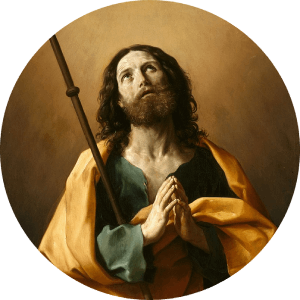St James (3-44)
Apostle
Born: Bethsaida, Galilee, Roman Empire, around AD 3
Died: AD 44 Jerusalem, Judea, Roman Empire
Canonized: Pre-Congregation
Patron: Against arthritis; against rheumatism; Antigua, Guatemala; apothecaries; blacksmiths; Chile; Compostela, Spain; druggists; equestrians; furriers; Galicia, Spain; Guatemala; horsemen; knights; laborers; Medjugorje, Bosnia-Herzegovina; Nicaragua; pharmacists; pilgrims; Pistoia, Italy; rheumatoid sufferers; riders; soldiers; Spain; Spanish conquistadors; tanners; veterinarians.
St. James, known as the Greater, in order to distinguish him from the other Apostle St. James, our Lord’s cousin, was St. John’s brother. With Peter and John he was one of the witnesses of the Transfiguration, as later he was also of the agony in the garden. He was beheaded in Jerusalem in 42 or 43 on the orders of Herod Agrippa. Since the ninth century Spain has claimed the honour of possessing his relics, though it must be said that actual proof is far less in evidence than the devotion of the faithful. The pilgrimage to St. James of Compostella in the Middle Ages attracted immense crowds; after the pilgrimage to Rome or the Holy Land, it was the most famous and the most frequented pilgrimage in Christendom. The pilgrim paths to Compostella form a network over Europe; they are dotted with pilgrims’ hospices and chapels, some of which still exist. St. James is mentioned in the Roman Canon of the Mass.
COLLECT PRAYER
Almighty ever-living God, who consecrated the first fruits of your Apostles by the blood of Saint James, grant, we pray, that your Church may be strengthened by his confession of faith and constantly sustained by his protection. Through our Lord Jesus Christ, your Son, who lives and reigns with you in the unity of the Holy Spirit, God, for ever and ever.
Things to Do:
- Learn more about St. James here and here
- It is traditional in Spain to make a yearly pilgrimage to St. James of Compostela on July 24. Read more about this custom. From Catholic Culture’s Library: Pilgrimage To The Stars and Cycling through time on the Camino de Santiago.
- Read about Santiago de Compostela, the third largest shrine in all of Christendom.
- Learn more about the pilgrimage to St. James.
- Santiago de Compostela, the capital of Galicia and final destination of the famous pilgimage way is certainly among Spain’s most beautiful cities. You can take a virtual tour and learn all about this area of the world here.
- Watch this Spanish news broadcast of the faithful bringing flowers for Our Lady of the Pillar on October 12 during the celebration of the feast at the cathedral, notice the open devotion and enthusiam offered to Our Lady. Tradition says that Mary appeared to St. James before her Assumption. Read more about the apparition here.
- Plan your own pilgrimage to a nearby shrine. Pope John Paul II said, “To go in a spirit of prayer from one place to another, from one city to another, in the area marked especially by God’s intervention, helps us not only to live our life as a journey, but also gives us a vivid sense of a God who has gone before us and leads us on, who himself set out on man’s path, a God who does not look down on us from on high, but who became our traveling companion.” Read this letter and try to incorporate its spirit into your pilgrimage.
St. James
In Spain, he is called El Senor Santiago, the patron saint of horsemen and soldiers, and his great shrine at Santiago de Compostela in that country has been a place of pilgrimage for centuries. He is one of those that Jesus called Boanerges, “son of thunder,” the brother of John the Evangelist and the son of Zebedee the fisherman from Galilee.
St. James the Greater and his brother John were apparently partners with those other two brothers, Peter and Andrew, and lived in Bethsaida, on the north shore of the Sea of Galilee. How and where James first met Jesus, we do not know; but there is an old legend that makes Salome, his mother, a sister of Mary, and if this were the case, he would have known Jesus from childhood.
Along with Peter and his brother John, James was part of the inner circle of Jesus, who witnessed the Transfiguration, were witnesses to certain of His miracles, like the raising of the daughter of Jairus, and accompanied Him to the Garden of Gethsemani. Like his brother, he was active in the work of evangelization after the death of Jesus, and one legend, very unlikely, even has him going to Spain after Jesus’ resurrection.
His prominence and his presence in Jerusalem must have been well known, for scarcely a dozen years after the Resurrection, he became involved in the political maneuverings of the day and was arrested and executed by King Herod Agrippa. This was followed by the arrest of Peter also, so his death must have been part of a purge of Christian leaders by Agrippa, who saw the new Christian movement as a threat to Judaism.
Jesus had foretold this kind of fate when He prophesied that James and his brother John would “drink of the same chalice” of suffering as Himself. The two brothers had asked to be seated at the right of Jesus and at His left in His kingdom, and Jesus told them that they would be with Him in a far different way than they expected.
James’s death is the only biblical record we have of the death of one of the Apostles, and he was the first of that chosen band to give his life for his Master.
— Excerpted from The One Year Book of Saints, Rev. Clifford Stevens
Source: Catholic Culture
